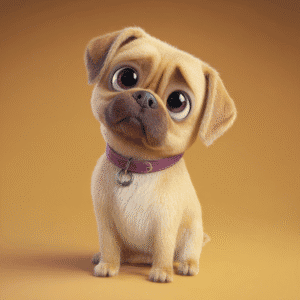The Puggle is one of the most popular modern crossbreeds, created in the 1990s by crossing a Pug with a Beagle. With the Pug’s distinctive wrinkles and the Beagle’s longer muzzle, they resemble miniature mastiffs with big personalities.
As with all crossbreeds, no two Puggles are exactly alike — some lean more toward the Pug, others toward the Beagle. But one thing’s for certain: they’re active, intelligent, and endlessly playful.
Puggle Traits at a Glance
- Best trait: Active and playful
- Challenging trait: Prone to weight gain
- Weight: 6–12 kg
- Height: 18–25 cm
- Lifespan: 12–15 years
Exercise Needs
Puggles need less exercise than high-energy breeds, but they still enjoy a daily walk and regular playtime. They can adapt to flat or apartment living if their exercise needs are met.
A bored Puggle can turn mischievous, resorting to barking, chewing, or digging. Keep them engaged with toys, games, and training challenges.
Temperament
Friendly, affectionate, and playful, Puggles make excellent family companions. They’re fantastic with children and love being part of the action, though they often bond most strongly with one special person in the household.
Watchdogs and Strangers
Puggles are sociable dogs who tend to love everyone they meet, including strangers. They may bark to announce visitors, but they’re more likely to welcome them than ward them off. If you’re looking for a watchdog, this isn’t the breed for you.
They may also inherit the Beagle’s tendency to howl, so think about your neighbours before bringing one home.
Living With a Puggle
- Other dogs and cats: Generally peaceful if raised together.
- Small animals: Can live alongside household pets but may still chase neighbourhood cats.
- Weight management: Prone to weight gain — exercise and portion control are key.
Training a Puggle
Puggles are intelligent but sometimes stubborn. They respond well to positive, reward-based training — food is usually their top motivator. Keep sessions short, playful, and consistent.
If you’d like tailored help with training challenges, check out Pickles, our AI Dog Trainer, designed to support new owners step by step.
Grooming Needs
- Short, low-maintenance coat
- Moderate shedding year-round, heavier in spring and autumn
- Weekly brushing helps keep hair under control
- No fancy clipping required
Pros and Cons of Owning a Puggle
| Pros | Cons |
|---|---|
| Friendly and affectionate | Can inherit Beagle howling or barking |
| Good with children | Prone to weight gain |
| Adaptable to flat/apartment living | Can be stubborn in training |
| Low-maintenance coat | May chase cats or small animals outside |
Health Notes
Puggles may inherit health issues from either parent breed, including:
- Hip dysplasia – joint issues are more common in medium breeds
- Brachycephalic airway issues – from the Pug side
- Obesity – particularly if overfed or under-exercised
Before committing, use our Best in Breeder Guide to ensure you ask the right questions about health checks.
History & Background
The Puggle was first bred in the United States during the 1990s as part of the rise in “designer dogs.” Breeders wanted to combine the Pug’s charm with the Beagle’s stamina and intelligence.
Sometimes nicknamed the Bug, Buggle, or Puggle, this crossbreed has become a much-loved companion in both the US and the UK.
Famous Puggle Owners
Puggles have found their way into the homes of many celebrities:
-
Kelly Osbourne – TV personality and singer.
-
Jake Gyllenhaal – Hollywood actor and Puggle fan.
-
Uma Thurman – Actress known for keeping a Puggle as her companion.
-
Sylvester Stallone – The Rocky star has also owned a Puggle.
Great Names for Puggles
Their cheeky charm and crossbreed heritage inspire fun names.
Cute Names
Peanut, Muffin, Biscuit, Tilly
Playful Names
Buster, Ziggy, Dash, Poppy
Quirky Names
Wrinkles, Noodle, Pickle, Bean
Need more inspiration? Try our Dog Name Generator, which suggests names based on personality and looks.
Thinking of Bringing Home a Puggle?
The Puggle is adaptable, affectionate, and playful, the perfect fit for many families. But they do need exercise, training, and careful weight management to thrive.
Get off to the best start with our New Puppy Paw-rent Planner, designed to make the first few months smoother with routines, trackers, and training tips.
Pickles’ Aside:
“Puggles are part Beagle, part Pug… which means they’ll howl for their dinner, eat it in five seconds, then beg for yours.”
Puggle Stats
- Origin: USA (1990s)
- Weight: 6–12 kg
- Height: 18–25 cm
- Lifespan: 12–15 years
- Best trait: Active and playful
- Challenging trait: Prone to weight gain

